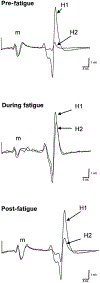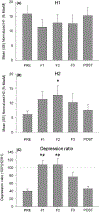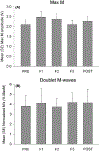Sustained submaximal contraction yields biphasic modulation of soleus Post-activation depression in healthy humans
- PMID: 30892718
- PMCID: PMC7702212
- DOI: 10.1111/sms.13421
Sustained submaximal contraction yields biphasic modulation of soleus Post-activation depression in healthy humans
Abstract
The amplitude of the H-reflex during the development and progression of fatigue reflects a complex interplay between central and peripheral factors. The purpose of this study is to characterize H-reflex homosynaptic post-activation depression (PAD) in an online fashion during a sustained submaximal fatigue task. The task required a high motor output in order to increase the likelihood of creating partial muscle ischemia with accumulation of fatigue metabolites, an important potential inhibitory influence upon the H-reflex during the progression of fatigue. Eleven subjects without neurologic impairment maintained volitional, isometric plantar flexion at 60% of maximal voluntary contraction until exhaustion. A paired-pulse stimulus (2 Hz) was delivered to the tibial nerve to elicit paired H-reflexes before, during, and after the fatigue protocol. The normalized amplitude of the second H-reflex (depression ratio) served as an estimate of PAD. Depression ratio increased during the first half of the fatigue protocol (P < 0.001), indicating a diminution of PAD, and then returned as exhaustion approached. The biphasic behavior of homosynaptic H-reflex depression during fatigue to exhaustion suggests a role for metabolic mediators of post-activation depression during fatigue.
Keywords: H-reflex; fatigue; homosynaptic depression; ischemia.
© 2019 John Wiley & Sons A/S. Published by John Wiley & Sons Ltd.
Figures




Similar articles
-
Modulation of motor unit discharge rate and H-reflex amplitude during submaximal fatigue of the human soleus muscle.Exp Brain Res. 2004 Oct;158(3):345-55. doi: 10.1007/s00221-004-1907-0. Epub 2004 May 14. Exp Brain Res. 2004. PMID: 15146306
-
Recurrent inhibition of soleus alpha-motoneurons during a sustained submaximal plantar flexion.Electroencephalogr Clin Neurophysiol. 1996 Aug;101(4):334-8. doi: 10.1016/0924-980x(96)95670-2. Electroencephalogr Clin Neurophysiol. 1996. PMID: 8761043
-
Central and peripheral contributions to fatigue in relation to level of activation during repeated maximal voluntary isometric plantar flexions.J Appl Physiol (1985). 2004 Jan;96(1):218-25. doi: 10.1152/japplphysiol.00650.2003. Epub 2003 Sep 12. J Appl Physiol (1985). 2004. PMID: 12972439
-
Changes in the reflex excitability during and after a sustained, low-intensity muscle contraction.Int J Sports Med. 2006 Feb;27(2):124-30. doi: 10.1055/s-2005-837490. Int J Sports Med. 2006. PMID: 16475058 Clinical Trial.
-
Contributions to the understanding of gait control.Dan Med J. 2014 Apr;61(4):B4823. Dan Med J. 2014. PMID: 24814597 Review.
Cited by
-
Myotonic dystrophy type 1 alters muscle twitch properties, spinal reflexes, and perturbation-induced trans-cortical reflexes.Muscle Nerve. 2020 Feb;61(2):205-212. doi: 10.1002/mus.26767. Epub 2019 Dec 6. Muscle Nerve. 2020. PMID: 31773755 Free PMC article.
References
-
- Calancie B, Broton JG, Klose KJ, Traad M, Difini J, Ayyar DR. Evidence that alterations in presynaptic inhibition contribute to segmental hypo- and hyperexcitability after spinal cord injury in man. Electroencephalogr Clin Neurophysiol. 1993;89:177–186. - PubMed
-
- Grey MJ, Klinge K, Crone C, et al. Post-activation depression of soleus stretch reflexes in healthy and spastic humans. Exp Brain Res. 2008;185:189–197. - PubMed
-
- Butler AJ, Yue G, Darling WG. Variations in soleus H-reflexes as a function of plantarflexion torque in man. Brain Res. 1993;632:95–104. - PubMed
MeSH terms
Grants and funding
LinkOut - more resources
Full Text Sources

